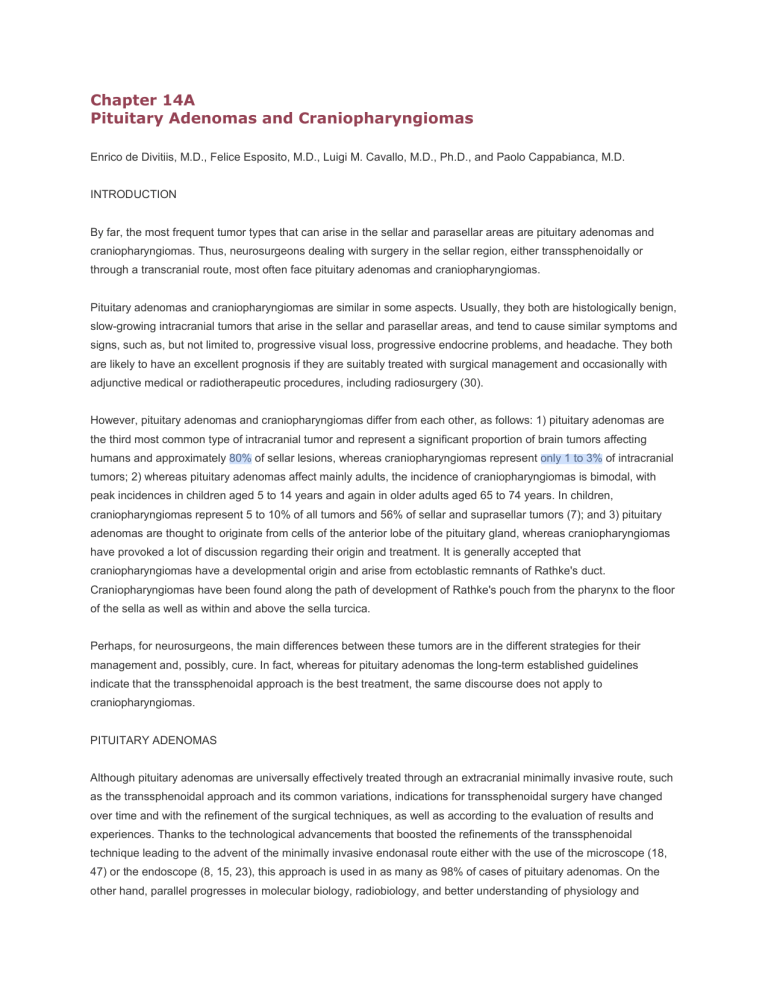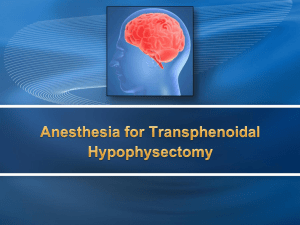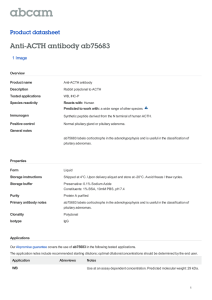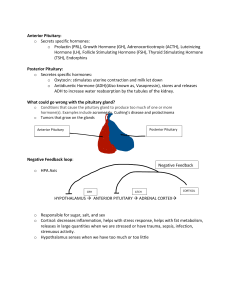
Chapter 14A Pituitary Adenomas and Craniopharyngiomas Enrico de Divitiis, M.D., Felice Esposito, M.D., Luigi M. Cavallo, M.D., Ph.D., and Paolo Cappabianca, M.D. INTRODUCTION By far, the most frequent tumor types that can arise in the sellar and parasellar areas are pituitary adenomas and craniopharyngiomas. Thus, neurosurgeons dealing with surgery in the sellar region, either transsphenoidally or through a transcranial route, most often face pituitary adenomas and craniopharyngiomas. Pituitary adenomas and craniopharyngiomas are similar in some aspects. Usually, they both are histologically benign, slow-growing intracranial tumors that arise in the sellar and parasellar areas, and tend to cause similar symptoms and signs, such as, but not limited to, progressive visual loss, progressive endocrine problems, and headache. They both are likely to have an excellent prognosis if they are suitably treated with surgical management and occasionally with adjunctive medical or radiotherapeutic procedures, including radiosurgery (30). However, pituitary adenomas and craniopharyngiomas differ from each other, as follows: 1) pituitary adenomas are the third most common type of intracranial tumor and represent a significant proportion of brain tumors affecting humans and approximately 80% of sellar lesions, whereas craniopharyngiomas represent only 1 to 3% of intracranial tumors; 2) whereas pituitary adenomas affect mainly adults, the incidence of craniopharyngiomas is bimodal, with peak incidences in children aged 5 to 14 years and again in older adults aged 65 to 74 years. In children, craniopharyngiomas represent 5 to 10% of all tumors and 56% of sellar and suprasellar tumors (7); and 3) pituitary adenomas are thought to originate from cells of the anterior lobe of the pituitary gland, whereas craniopharyngiomas have provoked a lot of discussion regarding their origin and treatment. It is generally accepted that craniopharyngiomas have a developmental origin and arise from ectoblastic remnants of Rathke's duct. Craniopharyngiomas have been found along the path of development of Rathke's pouch from the pharynx to the floor of the sella as well as within and above the sella turcica. Perhaps, for neurosurgeons, the main differences between these tumors are in the different strategies for their management and, possibly, cure. In fact, whereas for pituitary adenomas the long-term established guidelines indicate that the transsphenoidal approach is the best treatment, the same discourse does not apply to craniopharyngiomas. PITUITARY ADENOMAS Although pituitary adenomas are universally effectively treated through an extracranial minimally invasive route, such as the transsphenoidal approach and its common variations, indications for transsphenoidal surgery have changed over time and with the refinement of the surgical techniques, as well as according to the evaluation of results and experiences. Thanks to the technological advancements that boosted the refinements of the transsphenoidal technique leading to the advent of the minimally invasive endonasal route either with the use of the microscope (18, 47) or the endoscope (8, 15, 23), this approach is used in as many as 98% of cases of pituitary adenomas. On the other hand, parallel progresses in molecular biology, radiobiology, and better understanding of physiology and neuropsychopharmacology led to the advent of medical and radiotherapeutic adjuvant and/or neoadjuvant treatments. Today, for instance, we know that large invasive pituitary tumors are very difficult to cure, regardless of the approach, because the removal of every fragment of the tumor is often impossible; we know that extended transsphenoidal approaches or intentionally double-stage transsphenoidal approaches can sometimes represent a valid alternative to transcranial options; we know that excellent visual outcomes derive from the transsphenoidal method (10, 31); and we know that visual impairment does not indicate the need for a transcranial operation, as Cushing thought at one time (19). Surgical therapy for pituitary adenomas has to be targeted to reach the following goals: 1) normalization of excess hormone secretion; 2) preservation or restoration of normal pituitary function; 3) elimination of mass effect; 4) preservation or restoration of normal neurological function, visual acuity and/or visual field are more frequently affected; 5) prevention of tumor recurrence; 6) achievement of a complete histological diagnosis; and 7) obtaining tissue for scientific studies. Because pituitary tumors are biologically, endocrinologically, and pathologically a heterogeneous group of lesions, the role of surgery is different among different pituitary tumor subtypes. The primary role of surgery is established in: 1) nonfunctioning pituitary tumors; 2) Cushing’s disease, because of the inadequacy of pharmacological agents; 3) acromegaly, in combination with medical treatment (preoperative and/or postoperative, if necessary); and 4) secondary hyperthyroidism. The role of surgery in prolactinomas is secondary, but still necessary in selected conditions, such as: 1) failure of or resistance to medical treatment or intolerable side effects of medical therapy; 2) recurrences, in combination or in association with the other therapeutic, medical, and/or radiotherapeutic options; 3) choice of the patient, who may not want a lifelong medical therapy. Transcranial surgery for pituitary adenomas currently has very few indications and is only indicated in the rare occurrence of (45, 46): 1) tumors with extensive intracranial invasion (33); 2) tumors with asymmetrical suprasellar development, particularly if major vessel involvement is present; 3) dumbbell shaped adenomas (43); 4) suprasellar tumors not completely removable through the transsphenoidal route (2); 5) preoperative MRI showing a firm consistency of the adenoma, preventing easy debulking (21, 22, 38); 6) nonpneumatization of the sphenoid sinus (conchal-type), the sella being or not making it easy to reach the suprasellar extension of the tumor (35); and 7) presence of coexisting vascular (20, 34) and tumoral surgical pathology. The same technological advancements that have increased the use of the transsphenoidal approach for pathologies historically considered indications for the transcranial route, has also influenced the size of the craniotomy and the invasiveness of the transcranial approach. CRANIOPHARYNGIOMAS Craniopharyngiomas have provoked much discussion regarding their treatment because of their intimate association with important structures in and around the sella. It is generally accepted that the best chance of cure is total surgical excision, although some authors point out that craniopharyngiomas cannot be always totally excised with acceptable morbidity because of the proximity of and, sometimes, the dense attachment of the tumor to, important neighboring, neurovascular structures (36, 37). Thus, a cautious neurosurgical approach should be taken and complemented by radiation therapy or, in the case of cystic tumors, cyst sclerotherapy or stereotactic drainage (4, 40-42). The results are that craniopharyngiomas are often not totally removed, and even when total resection is thought to be achieved, the recurrence rate is as high as 15%. Secondary operations for recurrent tumors carry significant hazards to the patient and can be extraordinarily difficult technically. Persistent attempts at a total excision in face of these problems led to some fatalities and many instances of severe postoperative morbidity. This led to the concept of a safe, subtotal excision with postoperative radiation therapy to the tumor residue, with acceptable results. Another important aspect in determining the causes of tumor recurrence after craniopharyngioma removal is the pathology of the tumor. Although some authors think that the squamous papillary histological variant has a better prognosis with a lower recurrence rate (1, 25), others demonstrated that there is no difference in recurrence rate between papillary and adamantinomatous tumors (13, 16). Another field of discussion is the surgical approach for craniopharyngiomas, especially in case of intrasuprasellar lesions. Surgical management of craniopharyngiomas can be achieved with many different approaches and techniques, according to the localization and expansion of the tumor (37): 1) a pterional approach, which can be used alone or in combination with a transsphenoidal or transcallosal approach to remove large lesions; 2) a transcortical, transventricular approach, for giant cysts extending into the frontal lobe; 3) a transcallosal approach, for tumors extending into the third ventricle; 4) a transtemporal approach, for small retrochiasmatic lesions; 5) a transpetrosal– transtentorial approach, for large retrochiasmatic craniopharyngiomas with extension along the clivus; 6) a subfrontal unilateral or bilateral route, for tumors extending into the lower half of the third ventricle, or tumors expanding into the upper half of the third ventricle; a trans–lamina terminalis approach could be used in the case of a prefixed chiasm with the tumor extending into the interpeduncular prepontine cistern; and 7) a transsphenoidal approach, in intrasellar infradiaphragmatic lesions or in intrasuprasellar lesions with enlarged sella, preferably cistic. The best surgical approach can be selected only after careful evaluation of the topography of the lesion, on the basis of detailed preoperative neuroradiological studies (37). Nothing can be added to the transcranial approach that is not already well known, therefore, we will now focus our discussion on the transsphenoidal route and on recent advances and perspectives. In the absence of Class I evidence that seems unlikely to appear in the near future, the best mode of therapy for craniopharyngioma is not yet known (36). The Role of the Transsphenoidal Approach in Craniopharyngiomas The transsphenoidal approach is classically considered superior to other options only in cases of intrasellar infradiaphragmatic craniopharyngioma (17, 37). In fact, the long-term guidelines for the transsphenoidal approach regarding the treatment of craniopharyngiomas limited the indications for transsphenoidal approach only to tumors, preferably cystic, located purely in the intrasellar or infradiaphragmatic region. More recently, modification of the transsphenoidal approach and the use of the endoscope allowed the introduction of the extended transsphenoidal cranial base approach (9, 14, 24), wherein the bone of the tuberculum sellae and posterior planum sphenoidale between the optic canals is removed. Suprasellar lesions that have traditionally been approached transcranially, such as Grade II (tumor located in the cistern with or without intrasellar component) and III (tumor extending into the lower half of the third ventricle) craniopharyngiomas, and also tuberculum sellae meningiomas (11) and supraglandular Rathke’s cleft cysts, have been increasingly removed transsphenoidally (12, 26–29, 32, 44). Termed the extended transsphenoidal approach and originally described by Weiss in 1987 (44), this route allows excellent midline access and visibility to the suprasellar space while obviating brain retraction. Provided that the chiasm is not prefixed by the tumor and directly between the sphenoid sinus and tumor, or that a functional pituitary gland is not directly impeding the transsphenoidal route, the most obvious and significant advantages of the transsphenoidal approach are that: 1) brain retraction is obviated; 2) direct manipulation of the optic apparatus is minimized; 3) early identification of the pituitary gland and infundibulum increases the likelihood of preserving pituitary function; and 4) with the transsphenoidal approach, because these lesions generally displace the optic apparatus away from the surgeon, tumor removal can begin immediately after opening the dura, resulting in prompt chiasmal decompression. This early decompression likely allows removal of tumor adherent to the optic apparatus and/or its arachnoidal and vascular connections to be performed with less risk of visual worsening. The transsphenoidal technique does require a large opening of the dura over the tuberculum sellae and posterior planum sphenoidale and typically results in large intraoperative cerebrospinal fluid (CSF) leaks, which necessitates precise and effective dural closure to prevent a postoperative CSF leakage and meningitis, which, at the moment, represent the principal limits of such extended approaches. Other Therapeutic Possibilities for Craniopharyngiomas Especially after the introduction of stereotactic radiosurgery, radiation therapy became an important tool in the armamentarium for the treatment of craniopharyngiomas, which are known to be radiosensitive tumors. Radiation therapy could represent an important adjuvant option, thus, allowing the surgeon to not seek the total tumor removal at any cost. Another important aspect to consider is that approximately 60% of craniopharyngiomas are considered to be mixed, with both a solid and cystic component that can vary in relative amount. In such cases, a variety of treatments, including aspiration of the cyst and/or the endoscopic or stereotactic placement of an Ommaya reservoir can be attempted (39, 41). This can also allow intracavitary brachitherapy with the antibiotic, bleomycin (6), radioactive phosphorus (32P), or the â-emitting 90Y colloidale (3, 5). In fact, the squamous epithelial cells that are present in craniopharyngiomas are highly sensitive to these antineoplastic agents. If the solid part of the tumor is small enough initially, craniotomy can be avoided and the patient can be treated with gamma knife surgery directly (4, 42). Pituitary adenomas and craniopharyngiomas necessitate different treatment modalities even though they grow in the same area. In the surgical management of pituitary adenomas, the transsphenoidal approach and its recent variations (endonasal, endoscope-assisted, or purely endoscopic approaches) have a well-consolidate role. The modern possibilities offered by adjuvant treatments (drugs and radiosurgery) allow the surgeon to not seek the total removal of the lesion at all costs. This multidisciplinary approach limits the role of the transcranial approaches in the treatment of pituitary adenomas to rare and selected cases. Despite the technological innovations and the advances in molecular biology, radiobiology, and pharmacology, craniopharyngiomas remain a challenge. Surgery for craniopharyngiomas plays a primary role. The more the lesion is totally removed, the better the possibilities to cure the patient. To achieve such results, single or combined transcranial approaches are sometimes needed, thus, burdening the surgery by an underestimated rate of morbidity. The recent and increasing interest in the extended transsphenoidal approaches in the treatment of craniopharyngiomas is, in some ways, the expression of research into less invasive routes to obtain adequate surgical results while maintaining the physical integrity of the patient (9, 12, 14, 24, 26–29, 32, 44). Although the realization of extended transsphenoidal approaches is currently reserved to selected cases and in the hands of experienced neurosurgeons, preliminary results seem to open new horizons not yet completely explored. References 1. Adamson TE, Wiestler OD, Kleihues P, Yasargil MG: Correlation of clinical and pathological features in surgically treated craniopharyngiomas. J Neurosurg 73:12–17, 1990. 2. Alleyne CH, Jr., Barrow DL, Oyesiku NM: Combined transsphenoidal and pterional craniotomy approach to giant pituitary tumors. Surg Neurol 57:380–390; discussion 390, 2002. 3. Backlund EO, Axelsson B, Bergstrand CG, Eriksson AL, Noren G, Ribbesjo E, Rahn T, Schnell PO, Tallstedt L, Saaf M, et al.: Treatment of craniopharyngiomas—the stereotactic approach in a ten to twenty-three years' perspective. I. Surgical, radiological and ophthalmological aspects. Acta Neurochir (Wien) 99:11–19, 1989. 4. Barajas MA, Ramirez-Guzman G, Rodriguez-Vazquez C, Toledo-Buenrostro V, Velasquez-Santana H, del Robles RV, Cuevas-Solorzano A, Rodriguez-Hernandez G: Multimodal management of craniopharyngiomas: Neuroendoscopy, microsurgery, and radiosurgery. J Neurosurg 97:607–609, 2002. 5. Blackburn TP, Doughty D, Plowman PN: Stereotactic intracavitary therapy of recurrent cystic craniopharyngioma by instillation of 90yttrium. Br J Neurosurg 13:359–365, 1999. 6. Broggi G, Franzini A: Bleomycin for cystic craniopharyngioma. J Neurosurg 84:1080–1081, 1996. 7. Bunin GR, Surawicz TS, Witman PA, Preston-Martin S, Davis F, Bruner JM: The descriptive epidemiology of craniopharyngioma. J Neurosurg 89:547–551, 1998. 8. Cappabianca P, de Divitiis E: Endoscopy and transsphenoidal surgery. Neurosurgery 54:1043–1048; discussions 1048–1050, 2004. 9. Castelnuovo P, Locatelli D, Mauri S: Extended endoscopic approaches to the skull base. Anterior cranial base CSF leaks, in de Divitiis E, Cappabianca P (eds): Endoscopic Endonasal Transsphenoidal Surgery. Wien-New York, Springer, 2003, pp 137–158. 10. Cohen AR, Cooper PR, Kupersmith MJ, Flamm ES, Ransohoff J: Visual recovery after transsphenoidal removal of pituitary adenomas. Neurosurgery 17:446–452, 1985. 11. Cook SW, Smith Z, Kelly DF: Endonasal transsphenoidal removal of tuberculum sellae meningiomas: Technical note. Neurosurgery 55:239–244; discussion 244–236, 2004. 12. Couldwell WT, Weiss MH, Rabb C, Liu JK, Apfelbaum RI, Fukushima T: Variations on the standard transsphenoidal approach to the sellar region, with emphasis on the extended approaches and parasellar approaches: Surgical experience in 105 cases. Neurosurgery 55:539–547; discussion 547–550, 2004. 13. Crotty TB, Scheithauer BW, Young WF Jr, Davis DH, Shaw EG, Miller GM, Burger PC: Papillary craniopharyngioma: A clinicopathological study of 48 cases. J Neurosurg 83:206–214, 1995. 14. de Divitiis E, Cappabianca P, Cavallo LM: Endoscopic transsphenoidal approach: Adaptability of the procedure to different sellar lesions. Neurosurgery 51:699–705; discussion 705–697, 2002. 15. de Divitiis E, Cappabianca P, Cavallo LM: Endoscopic endonasal transsphenoidal approach to the sellar region, in de Divitiis E, Cappabianca P (eds): Endoscopic Endonasal Transsphenoidal Surgery. Wien/New York, Springer, 2003, pp 91–130. 16. Duff JM, Meyer FB, Ilstrup DM, Laws ERJ, Schleck CD, Sheithauer BW: Long-term outcomes for surgically resected craniopharyngiomas. Neurosurgery 46:291–302; discussion 302–295, 2000. 17. Fahlbusch R, Honneger J, Buchfelder M: Transsphenoidal microsurgery for craniopharyngiomas, in Schmidek HH (ed): Shmidek & Sweet Operative Neurosurgical Techniques. Indications, Methods and Results. Philadelphia, W. B. Saunders, 2000, pp 503–511. 18. Griffith HB, Veerapen R: A direct transnasal approach to the sphenoid sinus. Technical note. J Neurosurg 66:140–142, 1987. 19. Henderson WR: The pituitary adenomata. A follow-up study of the surgical results in 338 cases (Dr Harvey Cushing's series). Br J Surg 26:811–921, 1939. 20. Hermier M, Turjman F, Tournut P, Laharotte JC, Sindou M, Froment JC, Duquesnel J: Intracranial aneurysm associated with pituitary adenoma shown by MR angiography: Case report. Neuroradiology 36:115–116, 1994. 21. Ishii K, Ikeda H, Takahashi S, Matsumoto K, Ishibashi T, Tazawa S: MR imaging of pituitary adenomas with sphenoid sinus invasion: Characteristic MR findings indicating fibrosis. Radiat Med 14:173–178, 1996. 22. Iuchi T, Saeki N, Tanaka M, Sunami K, Yamaura A: MRI prediction of fibrous pituitary adenomas. Acta Neurochir (Wien) 140:779–786, 1998. 23. Jho HD, Carrau RL: Endoscopic endonasal transsphenoidal surgery: Experience with 50 patients. J Neurosurg 87:44–51, 1997. 24. Jho HD, Ha HG: Endoscopic endonasal skull base surgery: Part 1—The midline anterior fossa skull base. Minim Invasive Neurosurg 47:1–8, 2004. 25. Kahn EA, Gosch HH, Seeger JF, Hicks SP: Forty-five years experience with the craniopharyngiomas. Surg Neurol 1:5–12, 1973. 26. Kaptain GJ, Vincent DA, Sheehan JP, Laws ER Jr: Transsphenoidal approaches for the extracapsular resection of midline suprasellar and anterior cranial base lesions. Neurosurgery 49:94–100; discussion 100–101, 2001. 27. Kim J, Choe I, Bak K, Kim C, Kim N, Jang Y: Transsphenoidal supradiaphragmatic intradural approach: Technical note. Minim Invasive Neurosurg 43:33–37, 2000. 28. Kitano M, Taneda M: Extended transsphenoidal approach with submucosal posterior ethmoidectomy for parasellar tumors. Technical note. J Neurosurg 94:999–1004, 2001. 29. Kouri JG, Chen MY, Watson JC, Oldfield EH: Resection of suprasellar tumors by using a modified transsphenoidal approach. Report of four cases. J Neurosurg 92:1028–1035, 2000. 30. Laws ER Jr.: Foreword, in De Divitiis E, Cappabianca P (eds): Endoscopic Endonasal Transsphenoidal Surgery. Wien/New York, Springer, 2003, pp V–VII. 31. Laws ER Jr, Trautmann JC, Hollenhorst RW Jr: Transsphenoidal decompression of the optic nerve and chiasm. Visual results in 62 patients. J Neurosurg 46:717–722, 1977. 32. Mason RB, Nieman LK, Doppman JL, Oldfield EH: Selective excision of adenomas originating in or extending into the pituitary stalk with preservation of pituitary function. J Neurosurg 87:343–351, 1997. 33. Mortini P, Giovanelli M: Transcranial approaches to pituitary tumors. Op Tech in Neurosurg 5:1–13, 2002. 34. Revuelta R, Arriada-Mendicoa N, Ramirez-Alba J, Soto-Hernandez JL: Simultaneous treatment of a pituitary adenoma and an internal carotid artery aneurysm through a supraorbital keyhole approach. Minim Invasive Neurosurg 45:109–111, 2002. 35. Rhoton AL Jr: Operative techniques and instrumentation for neurosurgery. Neurosurgery 53:907–934; discussion 934, 2003. 36. Rutka JT: Craniopharyngioma. J Neurosurg 97:1–2; discussion 2, 2002. 37. Samii M, Samii A: Surgical management of craniopharyngiomas, in Schmidek HH (ed): Shmidek & Sweet Operative Neurosurgical Techniques. Indications, Methods and Results. Philadelphia, W. B. Saunders, 2000, pp 489–502. 38. Snow RB, Johnson CE, Morgello S, Lavyne MH, Patterson RH Jr: Is magnetic resonance imaging useful in guiding the operative approach to large pituitary tumors? Neurosurgery 26:801–803, 1990. 39. Spaziante R, de Divitiis E: Drainage techniques for cystic craniopharyngiomas. Neurosurg Quart 7:183–208, 1997. 40. Spaziante R, de Divitiis E, Irace C, Cappabianca P, Caputi F: Management of primary or recurring grossly cystic craniopharyngiomas by means of draining systems. Topic review and 6 case reports. Acta Neurochir (Wien) 97:95– 106, 1989. 41. Spaziante R, Irace C, de Divitiis E: Brachytherapy of cystic craniopharyngiomas. J Neurosurg 79:966–967, 1993. 42. Sweet HW: Craniopharyngiomas: A summary of data, in Schmidek HH (ed): Shmidek & Sweet Operative Neurosurgical Techniques. Indications, Methods and Results. Philadelphia, W. B. Saunders, 2000, pp 477–486. 43. Van Alpen HA: Microsurgical fronto-temporal approach to pituitary adenomas with extrasellar extension. Clin Neurol Neurosurg 78:246–256, 1975. 44. Weiss MH: The transnasal transsphenoidal approach, in Apuzzo MLJ (ed): Surgery of the Third Ventricle. Baltimore, Williams & Wilkins, 1987, pp 476–494. 45. Wilson CB: Role of surgery in the management of pituitary tumors. Neurosurg Clin N Am 1:139–159, 1990. 46. Yasargil MG: Transcranial surgery for large pituitary adenomas, in Yasargil MG (ed) Microneurosurgery: Microneurosurgery of CNS Tumors. Stuttgart, Georg Thieme Verlag, 1996, pp 200–204, 207. 47. Zada G, Kelly DF, Cohan P, Wang C, Swerdloff R: Endonasal transsphenoidal approach for pituitary adenomas and other sellar lesions: An assessment of efficacy, safety, and patient impressions. J Neurosurg 98:350–358, 2003.




